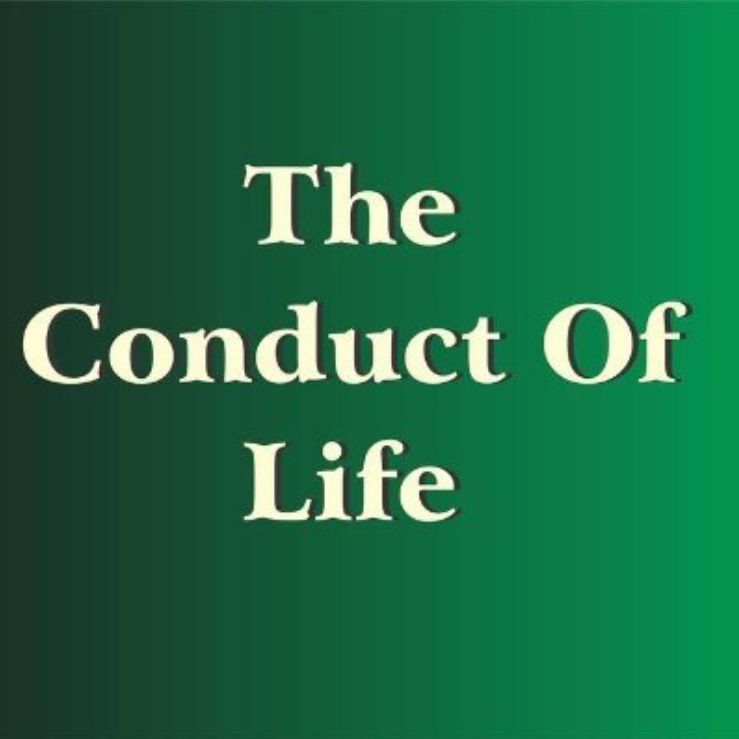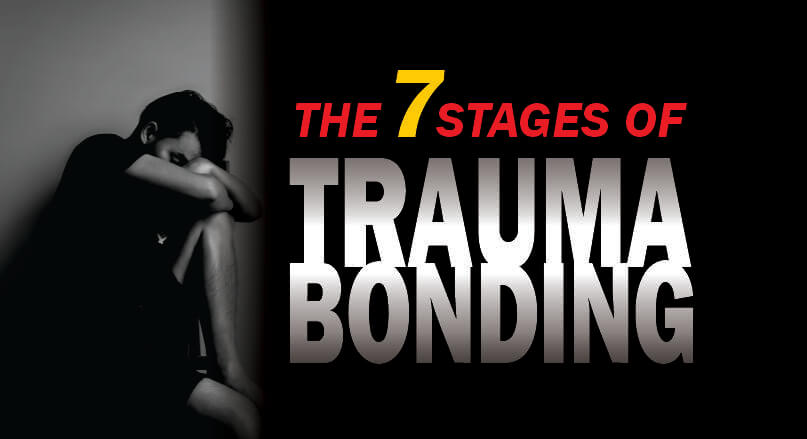Last updated on June 5th, 2025 at 04:58 pm
Understand the 7 stages of trauma bonding and learn how to break the cycle of emotional abuse, codependency, and toxic attachment.
Traumatic events or situations can have a serious impact on the mental functioning of people who experienced the trauma together and cause them to have unhealthy attachments.
It is important to understand that it is possible to break this bonding, heal and live a normal life.
This article will shed succinct light on trauma bonding, signs, effects, and how you can prioritize self-care to heal and move forward.
Table of Contents
- What Trauma Bonding is
- History of Trauma Bonding
- Causes of Trauma Bonding
- Importance of Understanding Trauma Bonding
- Overview of the 7 Stages of Trauma Bonding
- The 7 Stages of Trauma Bonding
- Overcoming Trauma Bonding
- The Trauma Bonding Test
- Conclusion
What Trauma Bonding is
Trauma bonding is a term used to describe a complex psychological phenomenon that occurs when an individual becomes emotionally attached to an abusive partner or situation.
It is a complex and often intense emotional attachment that can develop between individuals who have experienced intense and sometimes traumatic events together.
This phenomenon can occur in various types of relationships, such as romantic partnerships, friendships, or familial relationships.
Related: Mental Health 101: Understanding The Basics Of Mental Wellness
Trauma bonding can develop when two individuals share a traumatic experience, such as surviving a natural disaster, experiencing a violent attack, or being in a cult or abusive relationship.
The shared experience can create a deep and lasting emotional connection between the individuals, often resulting in feelings of dependence, loyalty, and protectiveness towards each other.
However, trauma bonding is not always a healthy attachment. In some cases, it can lead to codependency, where individuals rely on each other to cope with their trauma instead of seeking professional help.
It can also occur in abusive relationships, where the abuser uses trauma bonding as a tactic to control and manipulate the victim.
Generally, it is a complex and nuanced phenomenon that can have both positive and negative effects on individuals and relationships.
History of Trauma Bonding
It was first introduced in the 1980s by psychologist Patrick Carnes, who used the term “betrayal bonding” to describe the strong attachment that some victims develop towards their abusers.
Since then, researchers and practitioners in the fields of psychology and domestic violence have continued to study and refine the concept of trauma bonding.
It is now understood to be a complex psychological process that can occur in any relationship where there is a power imbalance and a pattern of abuse.
Trauma bonding can manifest in different ways depending on the context and the individual.
For example, it may be seen in survivors of domestic violence, cult members, hostages, or prisoners of war.
While trauma bonding can make it difficult for victims to leave abusive relationships, it is important to note that it is not a sign of weakness or moral failing.
It is a natural response to the traumatic experience of abuse, and it can be overcome with support and resources.
Today, trauma bonding is recognized as a significant factor in the cycle of abuse and is often addressed in counseling and therapy for survivors of abuse.
Related: Addressing Relationship Insecurity with Gut Feelings

Causes of Trauma Bonding
Trauma bonding can be caused by a range of factors that create emotional disturbances in the victim to bring about unhealthy attachment:
- Childhood Abuse: Childhood abuse can create a pattern of emotional attachment in which the victim seeks love and validation from an abusive partner.
- Insecurity: People who are insecure and lack self-esteem may accept abusive behavior if they believe it is the only way they will be loved and accepted.
- Choice of Partners: People who have experienced abusive relationships may continue to choose abusive partners because they are familiar with the pattern and believe they can change the abuser.
- Emotional Dependence: Emotional dependence on a partner can result in staying in an abusive relationship, even when it is harmful.
- Isolation: Isolation can make it difficult for victims of abuse to leave an abusive relationship, as they may not have a support system or financial resources to leave.
- Fear: Fear of retaliation or physical harm can prevent victims from leaving an abusive relationship.
- Neurochemicals: Trauma bonding can be reinforced by neurochemicals such as dopamine, oxytocin, and endorphins, which are released during the cycle of abuse and can create a powerful attachment to the abuser.
Importance of Understanding Trauma Bonding
It is important to understand trauma bonding for many reasons so you can be able to identify it and seek help.
It is an essential step towards breaking the cycle of abuse and promoting healing and recovery for survivors.
Here is the importance of understanding this phenomenon:
- Recognizing Patterns of Abuse: Trauma bonding can occur in any type of relationship where there is an imbalance of power and control, and understanding the dynamics of this phenomenon can help individuals recognize patterns of abuse in their own relationships or in those of loved ones.
- Breaking the Cycle of Abuse: It can make it difficult for individuals to leave abusive relationships, even when they know they are harmful. By understanding its mechanics, individuals can take steps to break the cycle of abuse and move towards healing and recovery.
- Providing Effective Treatment: It can be a barrier to effective treatment for survivors of abuse. By understanding the dynamics of trauma bonding, therapists and other mental health professionals can develop more effective treatment plans that address the complex emotional and psychological effects.
- Empowering Survivors: Having a good understanding can help survivors of abuse feel less isolated and ashamed. It can also help them recognize that their experiences are not their fault and that they have the power to heal and move forward.

Overview of the 7 Stages of Trauma Bonding
The seven stages of trauma bonding were identified by Patrick Carnes, a leading expert in the field of addiction and trauma recovery.
These stages describe the process by which individuals become emotionally bonded to their abusers or those who have caused them harm.
However, not everyone who experiences trauma bonding will go through all seven stages, and these stages can happen in any order or combination.
Additionally, trauma bonding can occur in any type of relationship, including romantic relationships, friendships, and family relationships.
The 7 Stages of Trauma Bonding
Stage 1: Idealization
One of the key stages in the development of trauma bonding is idealization.
During this stage, the abuser may present themselves as perfect or flawless, and create a sense of dependency in the victim by meeting their emotional and psychological needs in ways that feel fulfilling and meaningful.
This stage can also be called the love bombing stage as the abuser may show extreme love to get the victim loyal.
It’s a stage of grooming to manipulate the victim into believing that they are the only person who can provide them with the emotional support and validation they need.
Idealization can also be reinforced through intermittent reinforcement, in which the abuser alternates between providing positive reinforcement and punishment, creating a sense of unpredictability that keeps the victim on edge and reliant on the abuser for stability.
Related: Personal Boundaries
Over time, idealization can create a powerful attachment between the victim and the abuser, making it difficult for the victim to leave the abusive situation or relationship.
This attachment can be further strengthened by feelings of shame, guilt, or fear that the victim may experience if they attempt to leave the relationship or situation.
In order to break free from trauma bonding, it is important to recognize the role that idealization plays in creating and maintaining the bond.
By becoming aware of the ways in which the abuser manipulates and controls their victim through idealization, victims can begin to take steps to disentangle themselves from the abusive situation and seek the support of friends and family or professionals.
Signs of Idealization Stage of Trauma Bonding
- You feel deeply attached to the abuser, even as you are aware they have hurt you in the past.
- You make excuses for the abuser’s behavior, and blame yourself for any problems in the relationship.
- You feel like you can’t live without the abuser, and may even experience physical symptoms when you are apart.
- You prioritize the abuser’s needs and feelings over your own and may feel guilty or ashamed if you don’t meet their expectations.
- You constantly seek the abuser’s approval and validation and may feel like your self-worth depends on their opinion of you.
- You feel a strong sense of loyalty and devotion to the abuser and may be reluctant to confide in others or seek help.
- You may ignore or dismiss warning signs or red flags in the relationship and may feel like no one else understands the depth of your connection to the abuser.
Stage 2: Devaluation
The devaluation stage of trauma bonding occurs when the abuser begins to withdraw affection, attention, and positive reinforcement from the victim.
This can be a confusing and painful experience for the victim, who may have become accustomed to receiving love and validation from the abuser during the idealization stage of the trauma bonding cycle.
During the devaluation stage, the abuser may become more critical, demanding, and even hostile towards the victim.
They may also begin to engage in behaviors that are overtly abusive, such as physical violence or emotional manipulation.
However, despite the abuse, the victim may still feel strongly attached to the abuser and may even blame themselves for the abuser’s behavior.
This stage of trauma bonding can be particularly challenging for victims, as they may feel trapped and unable to escape the relationship.
They may also struggle with feelings of low self-worth and a sense of dependency on the abuser for validation and love.
Signs of Devaluation Stage of Trauma Bonding
- The abuser may become more distant, dismissive, or angry towards the victim, often without explanation.
- The abuser may use gaslighting or other manipulative tactics to make the victim doubt their own perceptions and memories of the relationship.
- The abuser may threaten or carry out physical violence or sexual assault or may threaten to harm the victim’s loved ones.
- The victim may feel trapped, powerless, and unable to leave the relationship, despite the escalating abuse.
- The victim may experience feelings of shame, guilt, or self-blame for the abuse, and may believe that they deserve the mistreatment.
- The victim may isolate themselves from friends, family, and support networks, or may feel like they can’t reach out for help.
- The victim may experience symptoms of depression, anxiety, post-traumatic stress disorder (PTSD), or other mental health issues as a result of the abuse.
Stage 3: Trauma
The trauma stage of trauma bonding occurs after the abusive incident has taken place and is characterized by the signs of PTSD.
During this stage, the victim experiences intense emotions such as fear, shock, and disbelief.
They may feel like their world has been turned upside down, and they may struggle to make sense of what has happened to them.
In this stage, the victim may also experience physical symptoms such as headaches, nausea, and insomnia.
They may feel on edge and hyper-vigilant, always on the lookout for potential danger.
The victim may also experience feelings of guilt, shame, and self-blame, which can be reinforced by the abuser.
Related: Reasons for Your Exploitation in Your Relationships
Despite the trauma they have experienced, the victim may still feel emotionally attached to the abuser.
This can be due to a number of factors, including the abuser’s intermittent displays of affection or kindness, the victim’s desire to protect the abuser, and the victim’s belief that they are responsible for the abuse.
During the trauma stage of trauma bonding, it is common for the victim to experience a wide range of conflicting emotions.
They may feel anger and resentment towards the abuser one moment, and then feel a strong urge to reconcile with them the next.
This emotional turmoil can be difficult to navigate, and many victims may feel trapped and unable to escape the cycle of abuse.
Signs of Trauma Stage of Trauma Bonding
The trauma stage of trauma bonding can be characterized by a range of signs and symptoms that are often associated with traumatic experiences.
Common signs to look out for:
- Intense Emotional Reactions: Victims may experience intense emotions such as fear, shock, disbelief, and anger. They may feel overwhelmed and have difficulty regulating their emotions.
- Physical Symptoms: Traumatic experiences can manifest in physical symptoms such as headaches, nausea, insomnia, and fatigue. Victims may also experience muscle tension, shaking, and rapid heartbeat.
- Hyper-vigilance: Victims may be constantly on edge, hyper-vigilant, and easily startled. They may be unable to relax or feel safe and may be constantly scanning their environment for potential danger.
- Guilt and Self-blame: Victims may feel responsible for the abuse they have experienced, and may blame themselves for the abuser’s behavior. This can lead to feelings of guilt, shame, and self-doubt.
- Conflicting Emotions: Victims may experience conflicting emotions, such as love and hate, or a desire to both leave and reconcile with the abuser. These conflicting emotions can be confusing and make it difficult for the victim to make decisions.
- Disorientation: Victims may feel disoriented and have difficulty making sense of what has happened to them. They may struggle to remember details of the abuse or have gaps in their memory.
Stage 4: Triggering
The triggering stage of trauma bonding is the anxiety stage and occurs when the victim experiences a situation or stimulus that reminds them of the traumatic experience or the abuser.
This can result in intense anxiety and emotional and physiological reactions, fear, panic, and even physical symptoms such as shaking or sweating.
Triggers can take many forms, including sounds, smells, physical sensations, visual cues, and even certain words or phrases.
For example, a victim of domestic abuse may be triggered by the sound of a door slamming, the smell of alcohol, or the sight of a particular item of clothing worn by their abuser.
Related: Power Dynamics In Relationships: Understanding The Balance Of Control
In the triggering stage of trauma bonding, the victim may feel overwhelmed and unable to cope with the intense emotions and physical sensations that arise.
They may feel like they are reliving the traumatic experience and may struggle to distinguish between past and present.
This can lead to feelings of helplessness and hopelessness and can be extremely distressing for the victim.
Triggers are a common response to trauma, and experiencing them does not mean that the victim is weak or flawed in any way.
Rather, triggers are a natural response to the traumatic experience and can be an opportunity for the victim to process their emotions and seek support.
Signs of the Triggering Stage of Trauma Bonding
The triggering stage of trauma bonding is characterized by a heightened sense of anxiety, fear, and emotional distress when the abuser or captor is absent or when there is a perceived threat of separation.
Here are some signs that may indicate that an individual is in the triggering stage of trauma bonding:
- Obsessive Thoughts: The person may have constant thoughts about their abuser or captor, even when they are not present.
- Emotional Numbness: The individual may feel emotionally detached and numb as a way of coping with their situation.
- Hyperarousal: The person may be easily triggered and experience intense anxiety, panic attacks, or hypervigilance in the absence of their abuser or captor.
- Difficulty Sleeping: The individual may have difficulty falling asleep or staying asleep due to racing thoughts or nightmares.
- Dependency: The person may feel like they cannot function without their abuser or captor, and may have a strong desire to be with them at all times.
- Guilt and Shame: The person may feel guilty or ashamed for their feelings towards their abuser or captor, which can further reinforce their attachment.
Recommended: How to Cope With Undesirable Traits of Personality
Stage 5: Rationalization
The rationalization or denial stage occurs when a person in a trauma bond begins to justify or rationalize the abusive behavior of their partner, often in an attempt to minimize the harm caused and maintain the relationship.
During the rationalization stage, a person in a trauma bond may make excuses for their partner’s behavior or blame themselves for the abuse.
They may also focus on the positive aspects of the relationship and ignore the negative, or convince themselves that the abuse is a temporary problem that will be resolved in the future.
This stage can be particularly challenging because the person in the trauma bond may feel conflicted and confused about their feelings toward their partner.
They may want to leave the relationship, but feel unable to do so because of the strong emotional attachment they have formed.
Note that rationalization or denial is a common response to trauma, and is not a reflection of weakness or lack of character.
Signs of Rationalization Stage of Trauma Bonding
- Minimizing the Severity of the Abuse: The victim may downplay the seriousness of the abuse, believing that it wasn’t as bad as it actually was.
- Blaming themselves for the abuse: The victim may believe that they somehow caused the abuse to happen, or that they deserved it.
- Making Excuses for the Abuser’s Behavior: The victim may come up with reasons or justifications for why the abuser acted the way they did, such as blaming their own behavior or circumstances.
- Denying the Abuse: The victim may refuse to acknowledge that the abuse is happening or has happened, in order to avoid confronting the painful reality of the situation.
- Feeling trapped or Unable to Leave the Relationship: The victim may believe that they are unable to leave the abuser, either because they feel they have no other options or because they are emotionally attached to the abuser.
Stage 6: Enmeshment
Enmeshment is a stage of trauma bonding that occurs when a person becomes emotionally enmeshed with their abuser.
This stage is characterized by a sense of codependency and a deep emotional attachment to the abuser, despite the abusive behaviors.
During the enmeshment stage, the victim has the feeling they cannot live without their traumatizer and this feeling is layered with another feeling of their surviving dependent on the abuse.
They may have a distorted sense of reality and feel like the abusive relationship is normal, or that they deserve the abuse.
This stage can be particularly difficult to break free from because the victim may feel like they are losing a part of themselves if they leave the relationship.
They may also fear retaliation from the abuser, or feel like they have nowhere else to go.
In order to overcome the enmeshment stage of trauma bonding, it is important for the victim to seek help from a professional therapist or support group.
They may also need to create a safety plan for leaving the abusive relationship and take steps to build a support system outside of the relationship.
With time, patience, and support, it is possible to break free from the enmeshment stage and begin to heal from the trauma of the abusive relationship.
Signs of Enmeshment Stage of Trauma Bonding
- A Deep Emotional Attachment to the Abuser: The victim may feel a strong emotional connection to the abuser, even if the abuser is abusive and harmful.
- Dependency: The victim may feel like they cannot live without the abuser and may believe that they need the abuse in order to survive.
- Loss of Identity: The victim may feel like they are losing a part of themselves if they leave the relationship.
- Distorted Sense of Reality: The victim may believe that the abusive relationship is normal, or that they deserve the abuse.
- Fear of Retaliation: The victim is scared of retaliation from the abuser if they try to make a move from the relationship.
- Isolation: The victim may have few or no friends or family members outside of the relationship.
- Lack of Support: The victim may not have a support system outside of the relationship and may feel like they have nowhere else to go.
- Denial: The victim may deny or minimize the abuse and may make excuses for the abuser’s behavior.
Stage 7: Dissociation
Dissociation is a detachment stage of trauma bonding that occurs when a person disconnects from their emotions and experiences as a way to cope with the trauma of abuse.
During this stage, the victim may feel numb or detached from their surroundings and may have difficulty feeling or expressing emotions.
Dissociation can take many forms, such as depersonalization (feeling disconnected from one’s body), derealization (feeling like the world around them is unreal), or amnesia (having gaps in memory or forgetting important events).
This stage can be particularly challenging because the victim may not even be aware that they are dissociating or that their coping mechanism is unhealthy.
Related: Why You Should Trust Your Instincts In Relationships
They may also struggle with feelings of shame or guilt for not being able to cope with the abuse in a more effective way.
In order to overcome the dissociation stage of trauma bonding, it is important for the victim to seek help from a professional therapist or support group.
They may need to learn healthy coping mechanisms and develop a greater awareness of their emotions and experiences.
With time and support, it is possible to break free from the dissociation stage and begin to heal from the trauma of the abusive relationship.
Signs of Dissociation Stage of Trauma Bonding
- Numbness or Detachment: The victim may feel emotionally numb or disconnected from their surroundings.
- Memory Gaps: The victim may have difficulty remembering important events or may have gaps in their memory.
- Feeling like the World is Unreal: The victim may feel like the world around them is not real.
- Feeling Disconnected from One’s Body: The victim may feel like they are watching themselves from outside of their body.
- Difficulty Feeling or Expressing Emotions: The victim may struggle to feel or express emotions, or may feel like their emotions are out of control.
- Inability to Cope: The victim may feel like they are unable to cope with the trauma of the abuse.
- Feelings of Shame or Guilt: The victim may feel ashamed or guilty for not being able to cope with the abuse in a more effective way.
Overcoming Trauma Bonding

Overcoming trauma bonding requires a conscious effort to break free from the emotional and psychological ties that keep the victim in the abusive relationship. Here are some steps that can help:
1. Identify the Signs of Trauma Bonding
The first step in overcoming this malady is to recognize that it exists and understand the signs. These may include a strong emotional attachment to the abuser, fear of separation, and intense feelings of guilt, shame or self-blame.
2. Reach out for Support
Trauma bonding can be challenging to overcome alone. Seek help and support from loved ones or reputable mental health professionals. They can help you process your feelings and develop healthy coping mechanisms.
3. Re-establish Self-worth
Victims of abuse often feel worthless and powerless; this can make it difficult for them to leave toxic relationships. Work with a mental health professional to rebuild self-esteem and self-worth.
4. Learn Healthy Boundaries
Trauma bonding can make it hard for people to set boundaries. Learning ways to establish healthy boundaries and assertiveness can help break free from the abuser’s psychological control.
5. Create a Safety Plan
Safety is important when trying to overcome trauma bonding. Create a safety plan to protect yourself and set clear boundaries to ensure your physical and emotional well-being.
It is noteworthy that breaking free from trauma bonding takes time and patience.
It’s okay to seek professional help or support from loved ones. Remember that there is hope, and you can overcome this challenging experience.
The Trauma Bonding Test
The trauma bonding test is a series of questions that are designed to help an individual determine whether or not they are in a situation of trauma bonding.
The test is composed of several questions that aim to tap into different aspects of the individual’s experience.
These questions may include:
- Do you feel a strong emotional attachment to the abuser?
- Have you experienced intense feelings of love and affection towards the abuser?
- Have you found it difficult to leave the abuser, despite the harm they have caused you?
- Have you rationalized or minimized the abuse in your mind?
- Do you have the feeling that the abuser is your source of happiness?
- Have you found yourself making excuses for the abuser’s behavior, blaming yourself or others for their actions?
- Do you find yourself returning to the abuser, even after an escape or attempts to leave?
- Have you been threatened with harm or punishment if you try to leave the relationship?
These questions and others like them can help an individual to begin to recognize the ways in which they may be experiencing trauma bonding.
If an individual answer yes to many of these questions, it may indicate that they are in an unhealthy situation and may need help and support to leave and heal.
It is important to note that the trauma bonding test is not an official diagnostic tool, but can be a helpful indicator to begin addressing your internal state and thought patterns towards potentially toxic relationships.
It is always helpful to speak with a licensed therapist or counselor to help contextualize your individual situation, assess your safety, assess the risk of the dynamic, and begin healing from any trauma experienced.
Conclusion
In conclusion, understanding the 7 stages of trauma bonding can be crucial in identifying and overcoming toxic relationships.
Trauma bonding can occur in any relationship where there is a power imbalance and a pattern of abuse.
The first stage involves the idealization of the abuser, followed by the devaluation stage, where the abuser begins to criticize and control the victim.
This leads to the stage of isolation, where the victim is cut off from support systems, making it harder to leave the relationship.
The trauma bond then intensifies in the stages of fear, guilt, and despair, making it increasingly difficult for the victim to break free.
However, with support and professional help, it is possible to overcome trauma bonding and heal from the effects of the abusive relationship.
Recognizing the signs and seeking help early on can be the first step in breaking the cycle and moving towards a healthier, happier life.
Frequently Asked Questions
What is trauma bonding?
It is an emotional attachment that develops between an individual and their abuser, typically as a result of prolonged emotional or physical abuse.
How does trauma bonding occur?
It occurs when an individual is exposed to ongoing emotional abuse, threats, or danger from another person.
As a means of survival, the individual may begin to develop an emotional attachment to their abuser, who may alternate between emotionally supportive and abusive behavior.
Why is trauma bonding harmful?
It can be damaging because it creates an intense emotional attachment to someone who is causing harm, making it difficult for the individual to leave the situation or seek help. It can also perpetuate cycles of abuse and make recovery more challenging.
How can trauma bonding be identified?
It can be identified by a range of symptoms, including a preoccupation or obsession with the abuser, difficulty leaving the relationship, feelings of guilt or shame, fear of the abuser, and an inability to trust others.
Is it possible to recover from trauma bonding?
Yes, recovery is possible with the help of therapy, support groups, and self-care.
It can take time and effort to heal from the psychological wounds caused by trauma bonding, but it is possible.
REFERENCES
- Trauma Bonding: What It Is and How to Cope
- Identifying & Overcoming Trauma Bonds
- Stages of Trauma Bonding
Pyo Merez (PsyD) is a distinguished adolescent and adult psychologist at the forefront of mental health advocacy.
With expertise in cognitive and developmental psychology, focusing on social relationships, cultural contexts, and individual differences, Pyo has dedicated his career to empowering adolescents and adults.
As a sought-after speaker and panelist, Pyo shares invaluable insights on issues affecting young people, contributing to a deeper understanding of mental health and well-being in today's society.



This is really insightful and valuable information for anyone who went through it. Thanks for sharing!